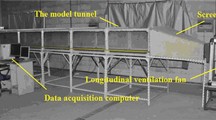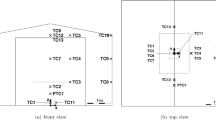Abstract
A number of measurements were made to help define the thermal and flow conditions in a 9 × 18 meter pool fire that was used to simulate a transportation accident. Temperatures were measured at twenty-eight locations throughout the continuous flame region. Velocities were measured at four vertical stations near the centerline of the pool. Heat fluxes were estimated from thermal measurements on and near vertical steel plates. As is often the case in fires of this size, the effects of mild, ambient winds on the measurements were pronounced. Attempts have been made to mitigate these effects by the application of conditional sampling. Temperatures and velocities are compared with other experimental results as well as results of modeling efforts.
Similar content being viewed by others
References
Zukoski, E.E., “Fluid dynamic aspects of room fires,”Proceedings of the first international symposium on fire safety science, 1–30 (1986).
McCaffrey, B.J., “Purely buoyant diffusion flames: Some experimental results,” U.S. National Bureau of Standards NBSIR 79–1910 (1979).
Babrauskas, V., “Estimating large pool fire burning rates,”Fire Technology,19, 251–261 (1983).
Longenbaugh, R.S., “Experimental and theoretical analysis of the radiative transfer inside of a sooty pool fire,” M.S. Thesis, New Mexico State University (1985).
Cox, G. & Chitty, R., “A Study of the deterministic properties of unbounded fire plumes,”Combustion and Flame,39, 191–209 (1980).
Cox, G. & Chitty, R., “Some source dependent effects of unbounded fires,”Combustion and Flame,60, 219–232 (1985).
Raj, P.K., “Analysis of JP—4 fire test data and development of a simple fire model,” ASME Paper Number 81-HT-17 (1981).
Johnson, H.T., Linley, L. J., & Mansfield J. A., “Measurement of the spacial dependence of temperature and gas and soot concentrations within large open hydrocarbon fuel fires,” NASA Technical Memorandum 58230 (1980).
Harsha, P.T., Bragg, W.N., & Edelman, R.B., “A mathematical model of a large open fire,” Science Applications Inc., NASA Contract Report NAS2.10675. (also NASA #SAI-81-026-CP) (1981).
Heskestad, G., “Peak gas velocities and flame heights of buoyancy controlled turbulent diffusion flames,”Eighteenth symposium (international) on combustion, The Combustion Institute, 951–959 (1981).
Kung, H.C. & Stavrianidis, P., “Buoyant plumes of large-scale pool fires,”Nineteenth symposium (international) on combustion, The Combustion Institute, 905–912 (1982).
Yamaguchi, T. & K. Wakasa, “Oil pool fire experiment,”Proceedings of the first international symposium on fire safety science, Hemisphere Publishing Co., 911–918 (1986).
Alger, R.S., Corlett, R.C., Gordon, F.A. and Williams, A.S., “Some aspects of structures of turbulent pool fires,”Fire Technology,15, 142–156 (1979).
Bader, B.E., “Heat transfer in liquid hydrocarbon fuel fires,”Chemical Engineering Progress Symposium Series,61 78–90 (1965).
Gordon, W. & McMillan, R.D., “Temperature distribution within aircraft-fuel fires,”Fire Technology,1 52–61 (1965).
Hagglund, B., “The heat radiation from petroleum fires,” Swedish Fire Protection Association, FoU-brand,1, 18–24 (1977).
Russell, L.H., “Quantification of the heat transfer parameters relevant to a cylinder immersed in a large aviation fuel fire,” M.S.M.E. Thesis, University of Pittsburgh (1970).
Russell, L.H., & Canfield, J.A., “Experimental measurement of heat transfer to a cylinder immersed in a large aviation-fuel fire,”J. Heat Transfer,95, 397 (1973).
Brinker, C.J., & Reed, S.T., “Low temperature process for obtaining thin glass films,” Sandia National Laboratories, Patent No. 4476156, Albuquerque, NM (1984).
McCaffrey, B. J., & Heskestad, G., “A robust bidirectional low-velocity probe for flame and fire application,”Combustion and Flame,26, 125–127 (1974).
Kent, L. A., & Schneider, M.E., “The design and application of bi-directional velocity probes for measurements in large pool fires,”ISA Transactions,26 25–32 (1987).
Gregory, J. J., Mata, R., Jr., & Keltner, N. R., “Thermal measurements in a series of large pool fires,” Sandia National Laboratories, SAND 85-0196, Albuquerque, NM (1987).
Gregory, J. J., Mata, R., Jr., & Keltner, N. R., “Thermal measurements in large pool fires,”24th National heat transfer conference, Pittsburgh (1987) (To be published inthe Journal of Heat Transfer.)
Blackwell, B. F., & Douglas, R. W., “A user's manual for the Sandia onedimensional direct and inverse thermal code,” Sandia National Laboratories, SAND85-2478, Albuquerque, NM (1986).
Beck, J. V., Blackwell, B. F., & St. Clair, C.R., Jr.,Inverse heat conduction. John Wiley & Sons (1985).
McCaffrey, B.J., “Momentum implications for buoyant diffusion flames,”Combustion and Flame,52, 149–167 (1983).
Author information
Authors and Affiliations
Rights and permissions
About this article
Cite this article
Schneider, M.E., Kent, L.A. Measurements of gas velocities and temperatures in a large open pool fire. Fire Technol 25, 51–80 (1989). https://doi.org/10.1007/BF01039723
Issue Date:
DOI: https://doi.org/10.1007/BF01039723




